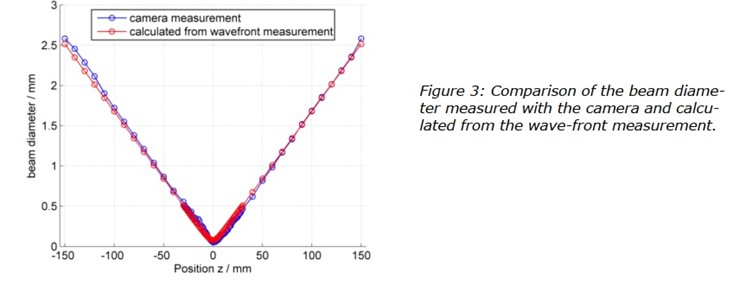Introduction
The SHSLab is a powerful and comprehensive wavefront measurement solution from Micro-Epsilon. Developed by Optocraft GmbH, a member of the Micro-Epsilon group of companies since 2018, SHSLab Shack Hartmann wavefront sensors are used for applications such as optics testing, optics alignment, and laser beam characterisation. Wavefront sensors are used in production and R&D in optics manufacturing, laser industries, astronomy, and space applications, as well as by contact- and intraocular lens manufacturers, including mobile phone optics, microscope, and photographic lenses.
Also read: Micro-Epsilon UK celebrates 20 years of positive growth
Using SHSLab Wavefront Sensor for Laser Beam Characterisation
For laser beam characterisation, the conventional camera-based method described in ISO 11146 requires several measurements at different locations along the beam path. When using a Shack Hartmann wavefront sensor, a single measurement is sufficient to characterise a laser beam with moderate or good beam quality. The following application describes the characterisation of a diode laser using the Optocraft SHSLab wavefront sensor.
Experimental Setup for Diode Laser Testing
A diode laser with a wavelength of 635nm, coupled to a single-mode fibre, is collimated by a lens with a small focal length and then focused by a second lens with a large focal length.
For comparison, a standard industrial camera with a pixel size of 3.75µm is first used to characterise the beam according to ISO 11146, taking several images of the beam cross-section at different positions along the beam. Next, the SHSLab wavefront sensor (type AR-S-130) is used to measure the wavefront at position zm = 144mm in the divergent part of the beam.
Beam Parameter Calculation Using Shack-Hartmann Wavefront Sensor
The SHSLab measurement provides the intensity and phase distribution at the measurement position zm. This enables the wavefront curvature radius R, the 1/e2-diameter of the beam d(zm), and the beam propagation factor M². M² is calculated from the second spatial/angular moments σi, σa, σia of the measured intensity distribution/wavefront:

(λ denotes the laser wavelength). Using this information, the position of the beam waist z0, the beam waist diameter dbw, and the Rayleigh length zR can be calculated by:

Comparison of Wavefront and Camera-Based Measurements for Laser Beam Quality
Figure 2 shows an example of the measured intensity distribution and wavefront used to calculate the beam parameters. From the wavefront/camera-based measurements, the values 1.14/1.10 for M², 0.056mm/0.053mm for dbw, and 3.57mm/3.52mm for zR can be obtained. It is important to note that these results are influenced by the noise present in the camera images and by the parameters used for the wavefront reconstruction.

Stability Analysis of Wavefront Measurements for Laser Systems
In order to analyse the stability of the wavefront measurement, continuous measurements were taken with a frame rate of 3Hz for a period of 30 minutes. The resulting mean values and standard deviations (rms) of the respective beam parameters are shown below. For all parameters, the fluctuations are reasonably small.

How to Measure Laser Beam Diameter with Wavefront Sensors
From the wavefront measurement taken at position zm = 144mm, the beam diameter d(z) is calculated at the positions where the single camera images for the beam characterisation according to ISO 11146 were taken using the equation:

The result gives a very good congruence of both methods (see plot in Figure 3). The maximum deviation between the diameter determined from the camera images and the diameter calculated from the wavefront measurement was 0.107mm, and the mean deviation was 0.034mm.

Shack Hartmann Wavefront Sensors for Optics and Optical Systems Testing
Optocraft SHSInspect instruments are widely used in R&D and production when performance, reliability, and efficiency matter most. Based on the state-of-the-art SHSLab Shack-Hartmann wavefront sensor, Optocraft offers measurement modules, turnkey instruments, and automated tools for a variety of applications in optics and optical systems, such as:
- objective lens testing
- testing of optical elements and windows
- surface shape measurement
- inline measurement and automation
Optocraft provides wavefront sensors and inspection systems that are distinguished by their high speed, single-shot measurements, excellent unreferenced accuracy, extreme dynamics, and broad spectral ranges. These sensors can measure wavefronts with strong higher-order aberrations, large tilt angles, and strongly defocused beams. Additionally, they offer high intrinsic stability, reliability, and powerful, customisable evaluation software, making them versatile and flexible for a range of uses. Optocraft’s systems are in operation in many demanding customer applications.










